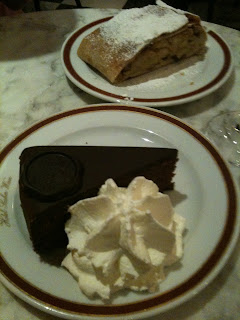The best gastronomic day of my life - at Niseko, Hokkaido
It's uncommon to have two back-to-back memorable once-in-a-lifetime meals. We had that happen on February 14, 2016 at Niseko, Hokkaido.
Thanks to the lousy weather that day (raining in Niseko), we decided to skip skiing and try our luck getting into Sobatei Rakuichi, a tiny 12-seater soba house made famous by Anthony Bourdain when he featured them back in February 2011. This wonderful small restaurant is in a tranquil, woodsy area away from the ski area. We got there at 11:05 AM (yes, admittedly a tad crazy) but we were the last two seated at the first lunch service; the next couple, who were right behind us and arrived at 11:10 AM, had to wait a whole hour to be seated in the next round.

This is a truly memorably experience, knowing that your soba was just rolled out and cut by hand after you ordered your dish and the cooking begins. Menu is simple - classic cold soba, cold soba with hot duck soup, or hot soba with duck, vegetable tempura. That's it! For a famous and highly sought after place, I was surprised at how inexpensive the menu was. The classic cold soba is only 900 Yen, about USD 8!

The soba was 'light' yet al dente. It didn't have the strong buckwheat taste of other sobas. The vegetable tempura was delicious, and served with a green tea salt (no dipping sauce). The duck soup was very tasty, with succulent slices of perfectly cooked duck. I also liked the side of spring onion tempura that came with the duck order.

The place is run by Rakuichi-san, the soba master, his wife and their daughter. They remain authentic to their craft, hospitable and calm as they feed the people who visit them from around the world with high expectations. Here's a link to a video demonstration of his soba making.
Our dinner that night was at Asperges Hanazono, located at one of the four base areas of the Niseko ski area. Having had our fair share of fine-dining experiences, we were impressed by this place. Most of this is attributed to high quality ingredients and 'respectful' cooking that allowed the ingredients to shine. Much of the cooking was done right at the fireplace, in the middle of the dining room, including grilled beef and casseroled items.

EVERY single dish was a standout - from the 4 amuse-bouche, the salads of 20 winter vegetables, the abalone first course, the grilled beef second course to the petit-four. What surprises me is that some sides, such as the risotto for the abalone and the gratin for the beef, are done in casseroles prepared for your table, and then served at table-side. That's highly unusual for fine dining. It reminds me of 'home-cooking' and the concept of sharing. Don't get me wrong, I can't home-cook these dishes!!
The 4 amuse-bouche dishes:
1) hokkaido oysters - fresh, creamy
2) flounder (raw) on rice cake with mixed herb salad - the combination of herbs is outstanding
3) botan shrimp lightly poached - they present the raw shrimp before cooking them. Served medium rare, it's really the best way to eat these shrimps
4) grilled smoked herring - didn't know herring could taste so complex, with a combination of smokiness and char
4) grilled smoked herring - didn't know herring could taste so complex, with a combination of smokiness and char
This is followed by a refreshing and colorful 20-vegetable winter salad. I ate each vegetable separately as they all have a slightly different taste, texture and preparation. How do they grow so many colorful vegetables in the winter? Hothouse would be my guess.

The next course is a knockout. Yes, I mean out of this world. Hokkaido abalone, seared lightly so that a crust is formed on the underside and served with a squid ink sauce, accompanied by a squid ink risotto. Every kernel of the risotto is flavorful, every bite of the abalone is succulent.

The main course was grilled beef with potato gratin and grilled turnip. Yes, it's the first (and also last time) we saw foam, thank goodness. Served with some wasabe (in place of traditional horseradish), this is an outstanding dish, especially the potato gratin (underneath the foam).

The petit 4 is a main dessert - "Baba au Sake," a kind of rum baba but with sake, followed by coconut meringue, homemade marshmallows and black beans coated with chocolate. The Baba au Sake is a standout - light yet crusted, in a light sake syrup.
We finished the feast with a snifter of 17-year old Hibiki whiskey - from Japan, of course.

I cannot believe that this has been such a tremendously good day - a fantastic lunch, followed by a wonderful dinner. Can't thank my lucky stars enough :-)








